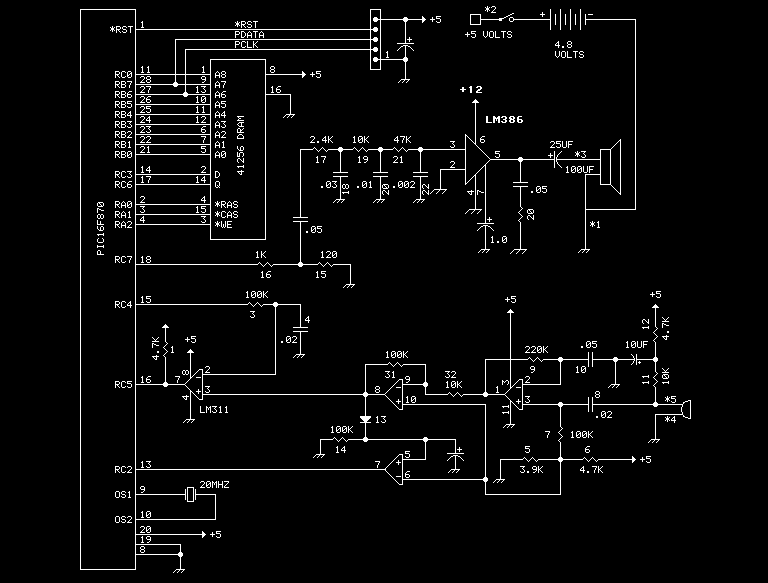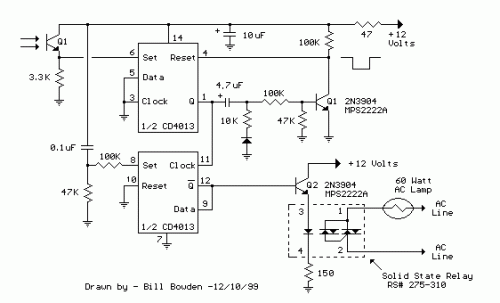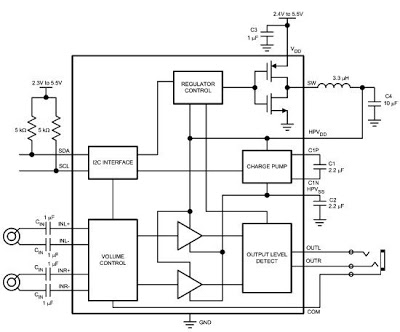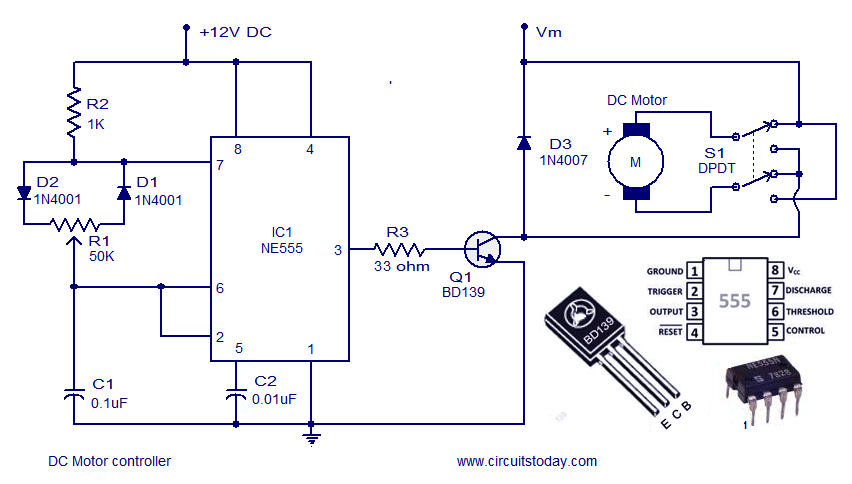
Talking Frog Box using PIC16F870

This device listens to conversations and then interjects words and phrases at inappropriate times. I got this box at a local thrift store for $1.50. It has a nice hinged top and a place to insert a panel with a design glued to it. I found this frog on the net and dug up the Egyptian border from somewhere on my hard drive - voila, Egyptian Frog Box! Starting from the ideas at this site, I tried using a single comparator IC to digitize sound. Very simply put, the incoming audio is sent to one input of the comparator. The other input connects back to the PIC chip via a simple RC network. The PIC reads the output of the comparator and then outputs a zero or one into the RC network. This causes the voltage from the RC to track the incoming audio signal. As each bit is output, it is also stored in memory for later playback. This allows the use of some really cheap single-bit DRAM chip to store the sound.
Here is what it all does: When a loud sound is heard with a pause before and after it (indicating some short word, phrase, or expletive), this device records the sound in one of eight memory banks. Then, at random times, when it detects another slight pause in the conversation, it plays out one of the recorded sounds.
This unit has now succeeded in really annoying several people.
Further experimentation in single-bit encoding is now in progress here. If you are doing some work in this area or are just interested in using some of this technology, let me know.
Here is the schematic as it now stands and the Source and Object files they stand at present. I have already mounted a small model airplane servo to raise the lid when it talks, but this has not been added to the design as yet.
The device operates by utilizing a comparator integrated circuit (IC) to convert analog audio signals into digital signals. The incoming audio is fed into the non-inverting input of the comparator, while the inverting input is connected to a feedback loop from a PIC microcontroller through a resistor-capacitor (RC) network. This feedback loop allows the PIC to adjust the threshold of the comparator based on the incoming audio levels, enabling it to accurately detect significant audio events.
When the comparator detects a loud sound followed by pauses, it triggers the PIC to store the audio data into one of eight designated memory banks. This storage is facilitated by a single-bit dynamic random-access memory (DRAM) chip, which is economical and effective for this application. The stored audio clips can later be randomly played back when the device senses another pause in the ongoing conversation, creating unexpected interjections.
The addition of a small servo motor to raise the lid of the box during playback adds a physical interaction element to the device, enhancing its novelty. The current schematic and source files provide a foundational layout for further development and experimentation, particularly in refining the single-bit encoding process and optimizing the playback mechanism. This device showcases an innovative approach to sound manipulation and can serve as a platform for further exploration in audio processing and interactive electronics.This device 'listens' to a conversations and then interjects words and phrases at inappropriate times. I got this box at a local thrift store for $1.50 (special, this week only). It has a nice hinged top and a place to insert a panel with a designed glued to it. Ok, so I found this frog on the net and dug up the Egyption boarder from somewhere on my hard drive - viola, Egyption Frog Box!
Starting from the ideas at this site, I tried using a single comparator ic to digitize sound. Very simply put, the incomming audio is sent to one input of the comparator. The other input connects back to the PIC chip via a simple r/c network. The PIC reads the output of the comparator and then outputs a zero or one into the r/c network. This causes the voltage from the r/c to 'track' the incomming audio signal. As each bit is output, it is also stored in memory for later playback. This allows the use of some really, really cheap, (aw heck, I got them for free) single bit DRAM chip to store the sound. Here is what it all does: When a loud sound is heard with a pause before and after it (indicating some short word, phrase, or explitive), this device records the sound in one of eight memory banks.
Then, at random times, when it detects another slight pause in the converstation, it plays out one of the recorded sounds. This unit has now succeeded in really anoying several people. Further experimentation in single-bit encoding is now in progress here. If you are doing some work in this area, or are just interested in using some of this technology, let me know.
Here is the schematic as it now and the Source and Object files they stand at present. I have already mounted a small model airplane servo to raise the lid when it talks, but this has not been added to the design as yet. 🔗 External reference
Here is what it all does: When a loud sound is heard with a pause before and after it (indicating some short word, phrase, or expletive), this device records the sound in one of eight memory banks. Then, at random times, when it detects another slight pause in the conversation, it plays out one of the recorded sounds.
This unit has now succeeded in really annoying several people.
Further experimentation in single-bit encoding is now in progress here. If you are doing some work in this area or are just interested in using some of this technology, let me know.
Here is the schematic as it now stands and the Source and Object files they stand at present. I have already mounted a small model airplane servo to raise the lid when it talks, but this has not been added to the design as yet.
The device operates by utilizing a comparator integrated circuit (IC) to convert analog audio signals into digital signals. The incoming audio is fed into the non-inverting input of the comparator, while the inverting input is connected to a feedback loop from a PIC microcontroller through a resistor-capacitor (RC) network. This feedback loop allows the PIC to adjust the threshold of the comparator based on the incoming audio levels, enabling it to accurately detect significant audio events.
When the comparator detects a loud sound followed by pauses, it triggers the PIC to store the audio data into one of eight designated memory banks. This storage is facilitated by a single-bit dynamic random-access memory (DRAM) chip, which is economical and effective for this application. The stored audio clips can later be randomly played back when the device senses another pause in the ongoing conversation, creating unexpected interjections.
The addition of a small servo motor to raise the lid of the box during playback adds a physical interaction element to the device, enhancing its novelty. The current schematic and source files provide a foundational layout for further development and experimentation, particularly in refining the single-bit encoding process and optimizing the playback mechanism. This device showcases an innovative approach to sound manipulation and can serve as a platform for further exploration in audio processing and interactive electronics.This device 'listens' to a conversations and then interjects words and phrases at inappropriate times. I got this box at a local thrift store for $1.50 (special, this week only). It has a nice hinged top and a place to insert a panel with a designed glued to it. Ok, so I found this frog on the net and dug up the Egyption boarder from somewhere on my hard drive - viola, Egyption Frog Box!
Starting from the ideas at this site, I tried using a single comparator ic to digitize sound. Very simply put, the incomming audio is sent to one input of the comparator. The other input connects back to the PIC chip via a simple r/c network. The PIC reads the output of the comparator and then outputs a zero or one into the r/c network. This causes the voltage from the r/c to 'track' the incomming audio signal. As each bit is output, it is also stored in memory for later playback. This allows the use of some really, really cheap, (aw heck, I got them for free) single bit DRAM chip to store the sound. Here is what it all does: When a loud sound is heard with a pause before and after it (indicating some short word, phrase, or explitive), this device records the sound in one of eight memory banks.
Then, at random times, when it detects another slight pause in the converstation, it plays out one of the recorded sounds. This unit has now succeeded in really anoying several people. Further experimentation in single-bit encoding is now in progress here. If you are doing some work in this area, or are just interested in using some of this technology, let me know.
Here is the schematic as it now and the Source and Object files they stand at present. I have already mounted a small model airplane servo to raise the lid when it talks, but this has not been added to the design as yet. 🔗 External reference


%2BCircuit%2Bdiagram%2Busing%2BCD4047%2Band%2BIRFZ44%2Bpower%2BMOSFET.png)


